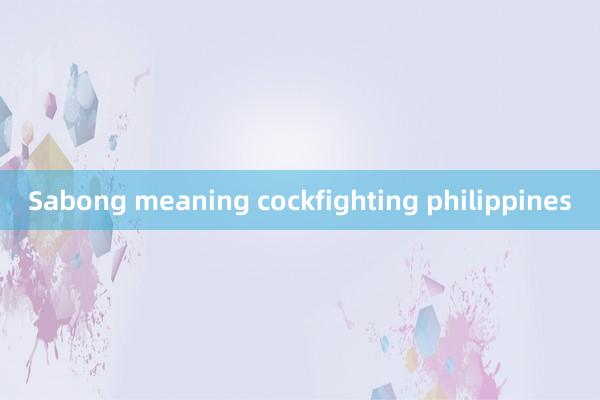
Sabong: The Meaning of Cockfighting in the Philippines
Cockfighting, locally known as "sabong" in the Philippines, is deeply embedded in the country's cultural and historical fabric. This age-old tradition has captivated Filipinos for centuries, blending entertainment, social bonding, and even gambling into a unique cultural spectacle. In this article, we will explore the meaning of sabong, its historical roots, cultural significance, and the debates surrounding its practice in the modern Philippines.
Historical Roots of Sabong
The origins of cockfighting in the Philippines trace back to pre-colonial times. It is believed that the tradition was introduced to the islands by early Malay settlers, who brought with them fighting roosters as part of their way of life. Over time, the practice became deeply ingrained in the local culture, and by the time the Spanish colonized the Philippines in the 16th century, cockfighting was already a well-established sport.
The Spaniards, recognizing the popularity of sabong among the locals, allowed its continuation and even institutionalized it to some extent. Cockfighting arenas, known as "sabungan," were established, and the Spanish colonial government regulated the sport through licenses and taxes. This official recognition of sabong ensured its survival through centuries of colonization, solidifying its place as a fixture of Filipino life.
Cultural Significance
In Filipino society, sabong is more than just a sport—it is a social and cultural event. Cockfighting is typically held in local arenas or even backyard pits, where large crowds of men gather to witness the fights. It serves as a meeting point for people from various walks of life, bringing together farmers, phim xet đồng tính nữ businessmen, phim sex móc lồn nhật bản politicians,phcrown and everyday citizens.
One of the key aspects of sabong is the camaraderie and social interaction it fosters. Participants and spectators engage in lively discussions, often debating the merits of different roosters, breeding techniques, and fight strategies. Betting is a significant part of the spectacle, with wagers placed on the outcome of matches. For many, winning a bet is less about the money and more about the thrill of backing the right rooster.
Sabong also holds a place of pride in the Philippines' rural communities. Roosters bred specifically for fighting are often treated with great care and respect. The breeding and training of fighting cocks are considered an art form, with enthusiasts devoting significant time and resources to ensure their roosters are in peak condition. These prized birds are seen as symbols of strength, courage, and honor, embodying qualities highly valued in Filipino culture.
The Cockfight Itself
tải go88A cockfight is a simple yet intense spectacle. Two roosters, often of the "Manok Panabong" breed, are placed in a small ring, each equipped with a sharp blade called a "tari" attached to one of their legs. The fight typically lasts just a few minutes, with the roosters fiercely attacking each other until one is killed or unable to continue. The winner is determined by which rooster remains standing.
While brutal by modern standards, cockfighting has always been framed in the context of tradition and cultural significance in the Philippines. The roosters are bred for this purpose, and the fights are regarded as a demonstration of the birds' natural instincts rather than an act of cruelty.
Sabong and Modern Society: Controversy and Legal Issues
Despite its long history and cultural significance, sabong is not without controversy in the modern Philippines. Animal rights groups have raised concerns over the cruelty of the sport, calling for its ban or stricter regulations. They argue that the practice promotes violence and exploits animals for entertainment and profit.
In response, advocates of sabong defend the practice as a cherished part of Filipino heritage, arguing that it should be preserved as a cultural tradition. They point out that cockfighting is legal in many countries and that in the Philippines, the sport is regulated by the government. Local ordinances govern when and where cockfights can take place, and most fights occur in licensed arenas. Special sabong events, such as the annual "World Slasher Cup," attract international attention and participants, further highlighting the sport's global reach.
During the COVID-19 pandemic, however, traditional sabong was severely impacted by restrictions on public gatherings. In its place, "e-sabong" emerged, an online version of cockfighting where spectators could place bets and watch fights remotely. While this adaptation allowed the sport to continue, it also sparked debates about the social and ethical implications of expanding gambling access through digital platforms. In 2022, after growing concerns over criminal activities tied to e-sabong, the Philippine government banned its operation.
Conclusion
Sabong remains an enduring part of the cultural landscape in the Philippines, reflecting the country's deep historical connections to the sport. While its practice has faced challenges in modern times, particularly from animal rights advocates and government regulation, it continues to be a source of entertainment and social interaction for many Filipinos. The debate over its future will likely persist, as the Philippines grapples with balancing tradition with modern values. For now, sabong continues to symbolize a unique blend of Filipino culture, heritage, and community, making it a fascinating, if controversial, aspect of the nation's identity.
PHCASH com casino loginwww.originalbristol.com


